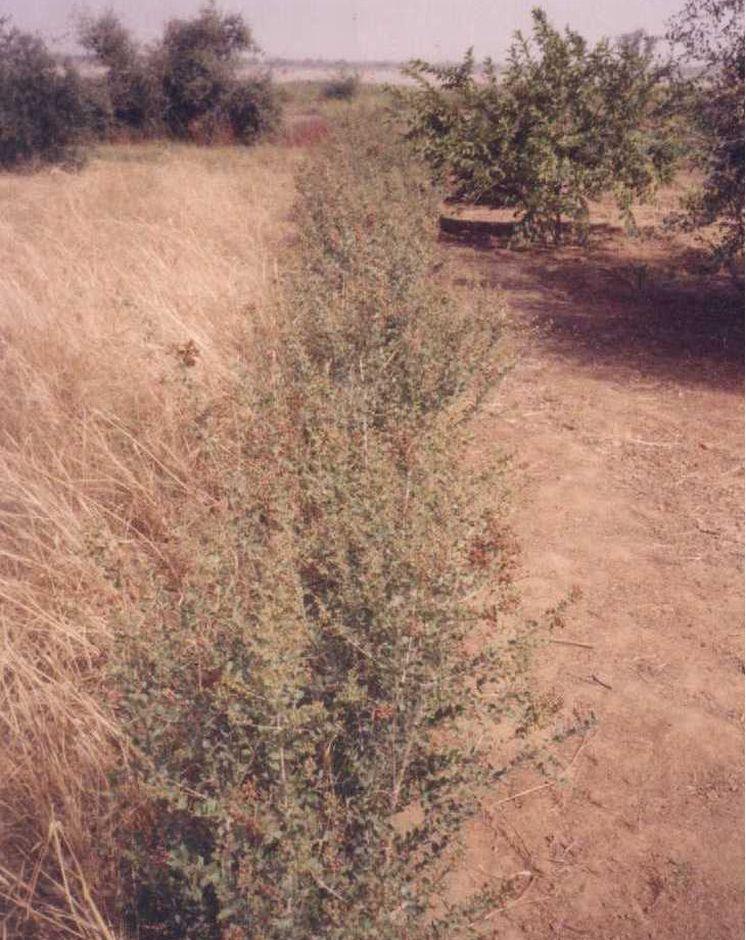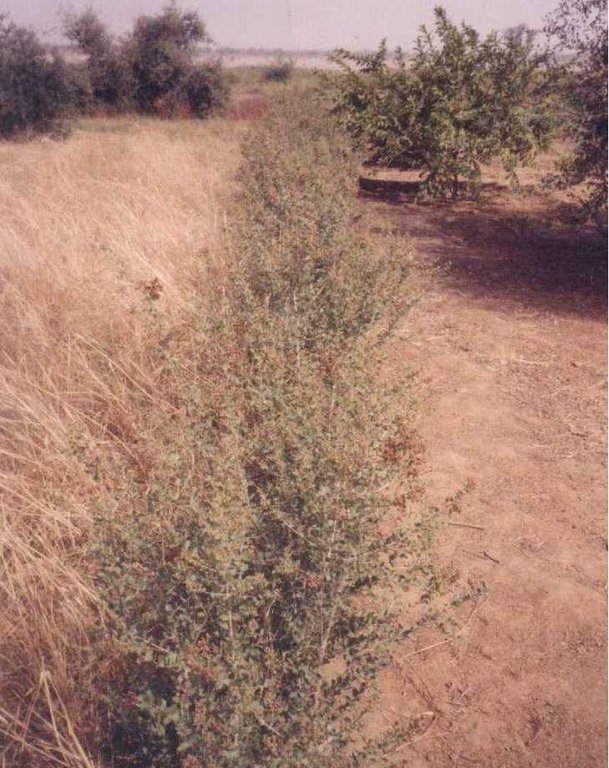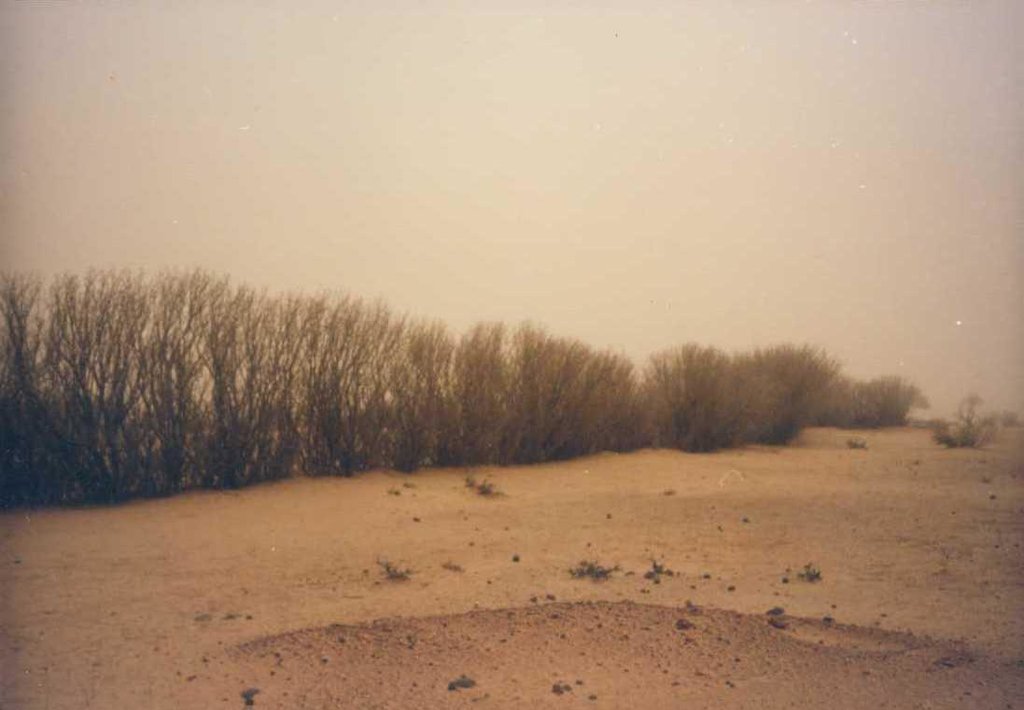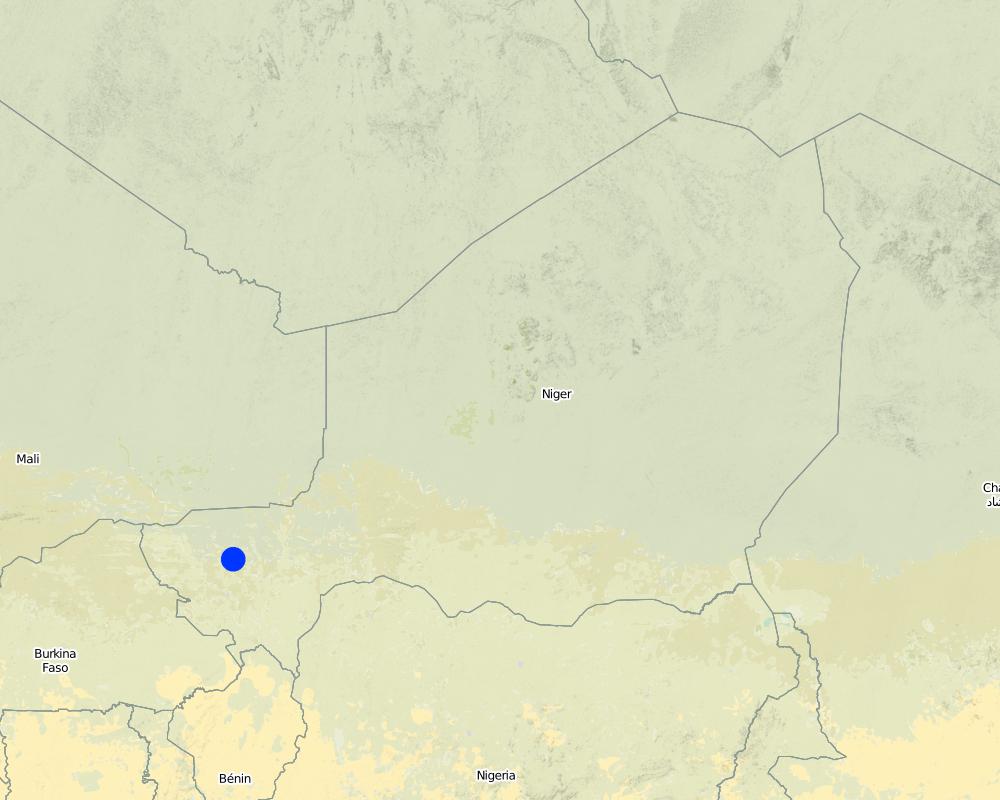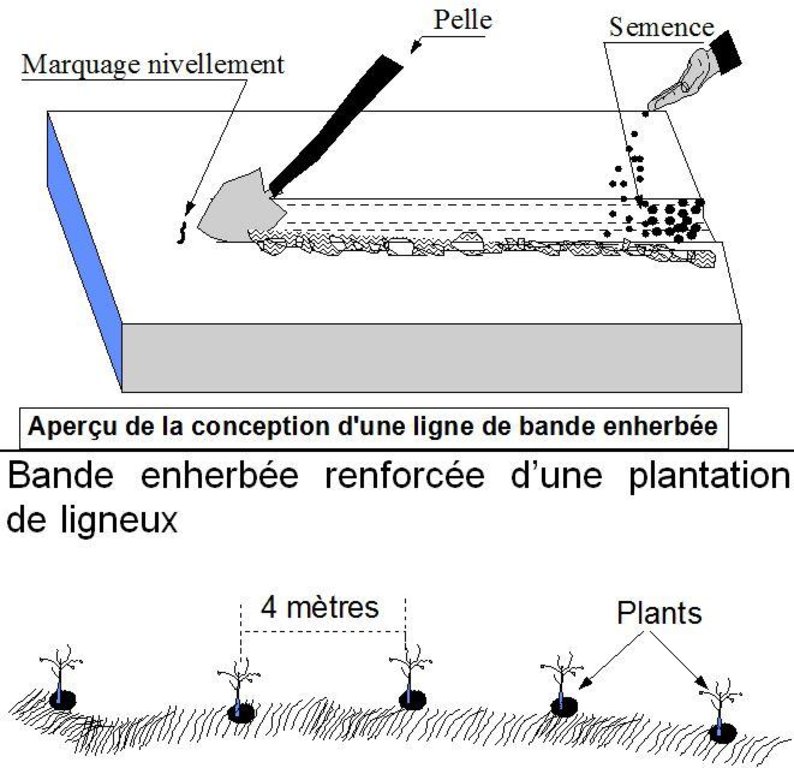Grass strips [Niger]
- Creation:
- Update:
- Compiler: Dieter Nill
- Editor: –
- Reviewers: Deborah Niggli, Alexandra Gavilano
Bandes enherbées (French)
technologies_1621 - Niger
View sections
Expand all Collapse all1. General information
1.2 Contact details of resource persons and institutions involved in the assessment and documentation of the Technology
SLM specialist:
Mamadou Abdou Gaoh Sani
Programme d’Appui à l’agriculture Productive (PROMAP), Niamey, Niger
Niger
Name of project which facilitated the documentation/ evaluation of the Technology (if relevant)
Good Practices in Soil and Water Conservation - A contribution to adaptation and farmers ́ resilience towards climate change in the Sahel (GIZ)Name of the institution(s) which facilitated the documentation/ evaluation of the Technology (if relevant)
Deutsche Gesellschaft für Internationale Zusammenarbeit (GIZ) GmbH (GIZ) - Germany1.3 Conditions regarding the use of data documented through WOCAT
The compiler and key resource person(s) accept the conditions regarding the use of data documented through WOCAT:
Yes
1.4 Declaration on sustainability of the described Technology
Is the Technology described here problematic with regard to land degradation, so that it cannot be declared a sustainable land management technology?
No
2. Description of the SLM Technology
2.1 Short description of the Technology
Definition of the Technology:
Grass strips slow down runoff, increase infiltration and retain sediment, thus increasing crop production.
2.2 Detailed description of the Technology
Description:
Grass strips measuring 0.80 m to 1 m wide are planted 20 to 80 m apart on low-gradient terrain. Local grasses (for example, Andropogon gayanus, Cymbopogon schoenateus and Vetivera nigritiana) are sown or planted (plantlets) at the start of the rainy season. Like stone bunds, grass strips are planted along the natural contour of the land to slow down runoff, increase infiltration and retain sediment. Grass strips get bigger as sediment builds up, which maintains their capacity to retain water, unlike mechanical structures (stone bunds and dikes).
The species of grass are chosen according to what the farmers want to use them for (straw, hay, mat weaving, roofing, construction of straw granaries, brooms, etc.). In cattle and sheep raising areas, the use of fodder plants can increase interest in this technique and ensure wider acceptance. It is recommended that the development of grass strips be combined with assisted natural regeneration (woody species) or the planting of trees.
Designed as an erosion control measure, grass strips slow down runoff in the event of heavy rain. They distribute rainwater more evenly over the land and improve infiltration which is particularly important when there are dry spells in the rainy season. Sediment builds up behind the grass strips, thereby reducing the erosion of fertile soil layers. The roots of the plants bind the soil and hold it in place. Although the vegetation growing in the strips competes with the crops to some extent for water, the overall effect on yields is positive. Crops are also protected from wind erosion. Thanks to the vegetation cover they provide, grass strips contribute to lowering soil temperature.
Like contour stone bunds, grass strips reduce the harmful effects of heavy rain and violent downpours, events that are expected to increase as a result of climate change.
Compared with plots without grass strips, millet yields were 50 kg per hectare per year higher, and straw yields 125 kg higher on plots with grass strips. Yields can be substantially improved by combining grass strips with the application of organic fertiliser, mulch or pen manure. The best results, an average increase of 280 kg of millet grain per hectare (370 kg of straw per hectare), were achieved by combining them with mulching and pen manuring. Grass strips therefore improve yields of cereals and forage for livestock (straw and grass growing on the strips).
Increased crop output increases household food security and improves livestock feeding. The straw cut on the grass strips can also be used for other purposes (fencing and roofing). It is also a source of income, as traditional products made with straw, such as woven mats, can be sold.
Grass growth tends to be patchy, and resowing is required several times to fill in the gaps in the strip. In order to protect the grass strips from grazing animals during the first year, it is recommended that the area be monitored, which requires strict control over the village herds and flocks and those of nomadic livestock keepers.
Some grasses tend to invade crop fields. It is therefore important to control them by cutting them down before they flower and to tend the strips regularly, straightening and cutting back the edges.
Any dead plants in the grass strips must be regularly replaced. Grass strips are more likely to be maintained if they are economically profitable, for example, if they produce hay for livestock or their output can be sold as forage or construction material.
It is a technique designed mainly for cropland, but can also be used on rangeland, provided that the plants are protected when the grass strips are put in place. Grass strips are suitable for areas in the Sahel and the Sudan with rainfall ranging between 400 and 1,000 mm/year and gently sloping terrain (< 2%). Ecological units that benefit from the implementation of this measure include dune land, pediments and plains (highland pediments). Grass strips are particularly appropriate for non-stony land in areas with higher rainfall levels.
2.3 Photos of the Technology
2.5 Country/ region/ locations where the Technology has been applied and which are covered by this assessment
Country:
Niger
Region/ State/ Province:
Niger
Further specification of location:
Filingué, Ouallam, Tillabéri, Tera
Specify the spread of the Technology:
- evenly spread over an area
If precise area is not known, indicate approximate area covered:
- 10-100 km2
Comments:
After three seasons of promoting this technique, grass strips had been established on a total area of 4674 hectares (sometimes in combination with other measures). Over half of the improved land is located in the Filingué area (2587 hectares), followed by Ouallam with 1042 hectares. However, only small areas were improved with grass strips in Tillabéri and Tera (228 hectares and 817 hectares respectively), where acceptance of this technique was low
Map
×2.6 Date of implementation
If precise year is not known, indicate approximate date:
- 10-50 years ago
2.7 Introduction of the Technology
Specify how the Technology was introduced:
- through projects/ external interventions
Comments (type of project, etc.):
developed, implemented and disseminated as part of projects and programmes undertaken from the 1980s onwards to combat desertification and improve natural resource management. Implemented by GIZ (German Federal Enterprise for International Cooperation), PDRT (Projet de développement rural de Tahoua - Tahoua Rural Development Project), PASP (Projet de protection intégrée des ressources agro-sylvo-pastorales Tillabéri-Nord - Project for the Integrated Protection of Agricultural, Forest and Rangeland Resources in Tillabéri-Nord), and PATECORE (project for land development and resource conservation in Plateau Central Burkina Faso)
3. Classification of the SLM Technology
3.1 Main purpose(s) of the Technology
- reduce, prevent, restore land degradation
3.2 Current land use type(s) where the Technology is applied

Cropland
- Annual cropping
Number of growing seasons per year:
- 1
Specify:
Longest growing period in days: 120, Longest growing period from month to month: August to October

Grazing land
Extensive grazing:
- Semi-nomadic pastoralism
Intensive grazing/ fodder production:
- Cut-and-carry/ zero grazing
Comments:
Major land use problems (compiler’s opinion): soil erosion by water and wind, fertility decline
Livestock density: 1-10 LU /km2
3.4 Water supply
Water supply for the land on which the Technology is applied:
- rainfed
3.5 SLM group to which the Technology belongs
- pastoralism and grazing land management
- cross-slope measure
3.6 SLM measures comprising the Technology

vegetative measures
- V1: Tree and shrub cover
- V2: Grasses and perennial herbaceous plants
Comments:
Type of vegetative measures: aligned: -contour
3.7 Main types of land degradation addressed by the Technology

soil erosion by water
- Wt: loss of topsoil/ surface erosion

soil erosion by wind
- Et: loss of topsoil

chemical soil deterioration
- Cn: fertility decline and reduced organic matter content (not caused by erosion)

water degradation
- Ha: aridification
Comments:
Main causes of degradation: soil management (Unadapted landuse methods, reduced or abandoned fallow periods), crop management (annual, perennial, tree/shrub) (Neglect of fallow periods and crop rotation), droughts (due to heat waves), population pressure (rapidly growing population increasing pressure on land), land tenure (insecure access to land and collectively managed communal land), poverty / wealth (very poor population)
Secondary causes of degradation: deforestation / removal of natural vegetation (incl. forest fires) (deforestation through overgrazing and fire wood collection), over-exploitation of vegetation for domestic use (firewood collection), overgrazing (cattle, sheep and goats), change in temperature (Climate change: heat waves), change of seasonal rainfall (more variable onset of rain), Heavy / extreme rainfall (intensity/amounts) (more variable and intensive rains), wind storms / dust storms (frequent storms), floods (due to intensive rain storms), labour availability (some migration of men to nearby cities), education, access to knowledge and support services (high level of illiteracy)
3.8 Prevention, reduction, or restoration of land degradation
Specify the goal of the Technology with regard to land degradation:
- prevent land degradation
- reduce land degradation
4. Technical specifications, implementation activities, inputs, and costs
4.1 Technical drawing of the Technology
Technical specifications (related to technical drawing):
Grass strips measuring 0.80 m to 1 m wide are planted 20 to 80 m apart on low-gradient terrain. Local grasses (for example, Andropogon gayanus, Cymbopogon schoenateus and Vetivera nigritiana) are sown or planted (plantlets) along the natural contour at the start of the rainy season.
Technical knowledge required for field staff / advisors: moderate
Technical knowledge required for land users: low
Main technical functions: control of dispersed runoff: retain / trap, control of dispersed runoff: impede / retard, control of concentrated runoff: retain / trap, control of concentrated runoff: impede / retard, improvement of ground cover, stabilisation of soil (eg by tree roots against land slides), increase in organic matter, increase in nutrient availability (supply, recycling,…), increase of infiltration, increase / maintain water stored in soil, water harvesting / increase water supply, sediment retention / trapping, sediment harvesting, reduction in wind speed, increase of biomass (quantity), promotion of vegetation species and varieties (quality, eg palatable fodder)
Secondary technical functions: increase of groundwater level / recharge of groundwater
Aligned: -contour
Vegetative material: T : trees / shrubs, G : grass
Number of plants per (ha): 200
Spacing between rows / strips / blocks (m): 20-80
Width within rows / strips / blocks (m): 0.8-1
Grass species: Andropogon gayanus, Cymbopogon schoenateus and Vetivera nigritiana
Author:
PASP
4.2 General information regarding the calculation of inputs and costs
other/ national currency (specify):
CFA Franc
4.3 Establishment activities
| Activity | Timing (season) | |
|---|---|---|
| 1. | marking out the contour lines | |
| 2. | making 10-15 cm deep furrows in which to plant the seeds or seedlings | |
| 3. | sowing or planting 1 to 4 rows per strip. |
4.4 Costs and inputs needed for establishment
| Specify input | Unit | Quantity | Costs per Unit | Total costs per input | % of costs borne by land users | |
|---|---|---|---|---|---|---|
| Labour | labour | ha | 1.0 | 46.7 | 46.7 | 100.0 |
| Plant material | seeds | ha | 1.0 | 3.3 | 3.3 | 100.0 |
| Total costs for establishment of the Technology | 50.0 | |||||
| Total costs for establishment of the Technology in USD | 50.0 | |||||
4.5 Maintenance/ recurrent activities
| Activity | Timing/ frequency | |
|---|---|---|
| 1. | resowing is required several times. Any dead plants in the grass strips must be regularly replaced. | |
| 2. | Cutting down grasses which invade crop fields. | |
| 3. | straightening and cutting back the edges |
4.7 Most important factors affecting the costs
Describe the most determinate factors affecting the costs:
Labour: 6 man-days per ha
• marking out the contour lines
• making 10-15 cm deep furrows in which to plant the seeds or seedlings
• sowing or planting 1 to 4 rows per strip. Upkeep: 2.5 man-days per year.
Other costs:
• grass seeds or seedlings
• equipment: water-tube level.
5. Natural and human environment
5.1 Climate
Annual rainfall
- < 250 mm
- 251-500 mm
- 501-750 mm
- 751-1,000 mm
- 1,001-1,500 mm
- 1,501-2,000 mm
- 2,001-3,000 mm
- 3,001-4,000 mm
- > 4,000 mm
Agro-climatic zone
- semi-arid
Thermal climate class: subtropics
5.2 Topography
Slopes on average:
- flat (0-2%)
- gentle (3-5%)
- moderate (6-10%)
- rolling (11-15%)
- hilly (16-30%)
- steep (31-60%)
- very steep (>60%)
Landforms:
- plateau/plains
- ridges
- mountain slopes
- hill slopes
- footslopes
- valley floors
Altitudinal zone:
- 0-100 m a.s.l.
- 101-500 m a.s.l.
- 501-1,000 m a.s.l.
- 1,001-1,500 m a.s.l.
- 1,501-2,000 m a.s.l.
- 2,001-2,500 m a.s.l.
- 2,501-3,000 m a.s.l.
- 3,001-4,000 m a.s.l.
- > 4,000 m a.s.l.
5.3 Soils
Soil depth on average:
- very shallow (0-20 cm)
- shallow (21-50 cm)
- moderately deep (51-80 cm)
- deep (81-120 cm)
- very deep (> 120 cm)
Soil texture (topsoil):
- medium (loamy, silty)
- fine/ heavy (clay)
Topsoil organic matter:
- low (<1%)
5.4 Water availability and quality
Ground water table:
5-50 m
Availability of surface water:
medium
Water quality (untreated):
for agricultural use only (irrigation)
5.5 Biodiversity
Species diversity:
- low
5.6 Characteristics of land users applying the Technology
Market orientation of production system:
- subsistence (self-supply)
Off-farm income:
- 10-50% of all income
Relative level of wealth:
- very poor
- poor
Level of mechanization:
- manual work
- animal traction
Gender:
- men
Indicate other relevant characteristics of the land users:
Population density: 10-50 persons/km2
Annual population growth: 3% - 4% (mostly poor households below poverty line).
Off-farm income specification: men migrate temporarily or permanently to cities for off-farm income, women and men seasonally carry out paid farm work
5.7 Average area of land used by land users applying the Technology
- < 0.5 ha
- 0.5-1 ha
- 1-2 ha
- 2-5 ha
- 5-15 ha
- 15-50 ha
- 50-100 ha
- 100-500 ha
- 500-1,000 ha
- 1,000-10,000 ha
- > 10,000 ha
Is this considered small-, medium- or large-scale (referring to local context)?
- small-scale
5.8 Land ownership, land use rights, and water use rights
Land ownership:
- state
- individual, not titled
Land use rights:
- open access (unorganized)
Water use rights:
- open access (unorganized)
Comments:
traditional land use rights prevail. On fields individual land use rights, communal rights on pasture and forest land (collection of wood and other products (fruits, medicinal plants))
5.9 Access to services and infrastructure
health:
- poor
- moderate
- good
education:
- poor
- moderate
- good
technical assistance:
- poor
- moderate
- good
employment (e.g. off-farm):
- poor
- moderate
- good
markets:
- poor
- moderate
- good
energy:
- poor
- moderate
- good
roads and transport:
- poor
- moderate
- good
drinking water and sanitation:
- poor
- moderate
- good
financial services:
- poor
- moderate
- good
6. Impacts and concluding statements
6.1 On-site impacts the Technology has shown
Socio-economic impacts
Production
crop production
fodder production
animal production
risk of production failure
production area
Comments/ specify:
Part of the plot is taken up by the grass strips, reducing the area left for growing crops
Income and costs
farm income
diversity of income sources
workload
Other socio-economic impacts
competition of grasses with crops
Socio-cultural impacts
food security/ self-sufficiency
conflict mitigation
contribution to human well-being
Comments/ specify:
Increased crop output increases household food security and improves livestock feeding. The straw cut on the grass strips can also be used for other purposes (fencing and roofing). It is also a source of income, as traditional products made with straw, such as woven mats, can be sold.
Ecological impacts
Water cycle/ runoff
harvesting/ collection of water
surface runoff
Soil
soil moisture
soil cover
soil loss
nutrient cycling/ recharge
Climate and disaster risk reduction
wind velocity
6.2 Off-site impacts the Technology has shown
downstream flooding
downstream siltation
wind transported sediments
6.3 Exposure and sensitivity of the Technology to gradual climate change and climate-related extremes/ disasters (as perceived by land users)
Gradual climate change
Gradual climate change
| Season | increase or decrease | How does the Technology cope with it? | |
|---|---|---|---|
| annual temperature | increase | well |
Climate-related extremes (disasters)
Meteorological disasters
| How does the Technology cope with it? | |
|---|---|
| local rainstorm | well |
| local windstorm | well |
Climatological disasters
| How does the Technology cope with it? | |
|---|---|
| drought | not well |
Hydrological disasters
| How does the Technology cope with it? | |
|---|---|
| general (river) flood | well |
Other climate-related consequences
Other climate-related consequences
| How does the Technology cope with it? | |
|---|---|
| reduced growing period | not known |
6.4 Cost-benefit analysis
How do the benefits compare with the establishment costs (from land users’ perspective)?
Short-term returns:
slightly positive
Long-term returns:
slightly positive
How do the benefits compare with the maintenance/ recurrent costs (from land users' perspective)?
Short-term returns:
slightly positive
Long-term returns:
slightly positive
6.5 Adoption of the Technology
Comments:
In the Tillabéri area, in northern Niger, the adoption of grass strips varies greatly from one place to another. After three seasons of promoting this technique, grass strips had been established on a total area of 4,674 hectares (sometimes in combination with other measures). Over half of the improved land is located in the Filingué area (2,587 hectares), followed by Ouallam with 1,042 hectares.
However, only small areas were improved with grass strips in Tillabéri and Tera (228 hectares and 817 hectares respectively), where acceptance of this technique was low.
In spite of good results in terms of increased production and soil improvement, grass strips have only been widely accepted in southern Niger (Maradi and Zinder). Farmers are of the view that grass strips could be confused with plot boundaries.
The availability of land in southern Niger may be another factor that facilitates acceptance of the measure is this area. Part of the plot is taken up by the grass strips, reducing the area left for growing crops. This hinders acceptance in areas where land is limited. The reduced crop-growing area is offset by better per-hectare grain, straw and hay yields. Certain grasses (such as Andropogon gayanus) have a harmful effect on nearby crops. The systematic exploitation of the grass strips as a source of straw or hay improves acceptance of the technique. In the Tillabéri area, in Niger, the adoption of grass strips varies greatly from one place to another. After three seasons of promoting this technique, grass strips had been established on a total area of 4,674 hectares (sometimes in combination with other measures). Over half of the improved land is located in the Filingué area (2,587 hectares), followed by Ouallam with 1,042 hectares. However, only small areas were improved with grass strips in Tillabéri and Tera (228 hectares and 817 hectares respectively), where acceptance of this technique was low. In spite of good results in terms of increased production and soil improvement, grass strips have only been widely accepted in southern Niger (Maradi and Zinder). Farmers are of the view that grass strips could be confused with plot boundaries. The availability of land in southern Niger may be another factor that facilitates acceptance of the measure is this area. Part of the plot is taken up by the grass strips, reducing the area left for growing crops. This hinders acceptance in areas where land is limited. The reduced crop-growing area is offset by better per-hectare grain, straw and hay yields. Certain grasses (such as Andropogon gayanus) have a harmful effect on nearby crops. The systematic exploitation of the grass strips as a source of straw or hay improves acceptance of the technique. At first, people living in the areas covered by the PDRT project were reluctant to establish grass strips. They considered them to be weeds with no place on their farmland. With time and exchange visits within the country, they began to accept the technique.
6.7 Strengths/ advantages/ opportunities of the Technology
| Strengths/ advantages/ opportunities in the compiler’s or other key resource person’s view |
|---|
| reduce the harmful effects of heavy rain and violent downpours, events that are expected to increase as a result of climate change |
| improve rainwater harvesting and water retention in the soil |
| contribute to creating vegetation cover, which provides a habitat for biodiversity |
| contribute to lowering soil temperature and are also effective in reducing wind erosion. As the vegetation provides shelter from the wind, fine particles of soil accumulate behind the strips. |
| Increased crop output increases household food security and improves livestock feeding. The straw cut on the grass strips can also be used for other purposes (fencing and roofing). It is also a source of income, as traditional products made with straw, such as woven mats, can be sold. |
6.8 Weaknesses/ disadvantages/ risks of the Technology and ways of overcoming them
| Weaknesses/ disadvantages/ risks in the compiler’s or other key resource person’s view | How can they be overcome? |
|---|---|
| Grass growth tends to be patchy, and resowing is required several times to fill in the gaps in the strip. Strips with bare patches are not effective in retaining water, and rilling can be caused by water gushing through the gaps. | The clumps must therefore be arranged in staggered rows and the strips made wide enough to prevent this problem. |
| With the use of certain types of grasses that grow in clumps, such as Andropogon grass, gaps are left between the tufts, and water spurting through these gaps can cause rilling. | |
| In spite of good results in terms of increased production and soil improvement, grass strips have only been widely accepted in southern Niger (Maradi and Zinder). Farmers are of the view that grass strips could be confused with plot boundaries. | |
| Certain grasses (such as Andropogon gayanus) have a harmful effect on nearby crops. | |
| Part of the plot is taken up by the grass strips, reducing the area left for growing crops. This hinders acceptance in areas where land is limited. |
7. References and links
7.1 Methods/ sources of information
- field visits, field surveys
- interviews with land users
When were the data compiled (in the field)?
01/07/2012
7.2 References to available publications
Title, author, year, ISBN:
Good Practices in Soil and Water Conservation. A contribution to adaptation and farmers´ resilience towards climate change in the Sahel. Published by GIZ in 2012.
Available from where? Costs?
http://agriwaterpedia.info/wiki/Main_Page
Links and modules
Expand all Collapse allLinks
No links
Modules
No modules


